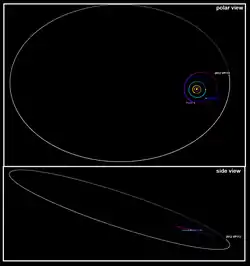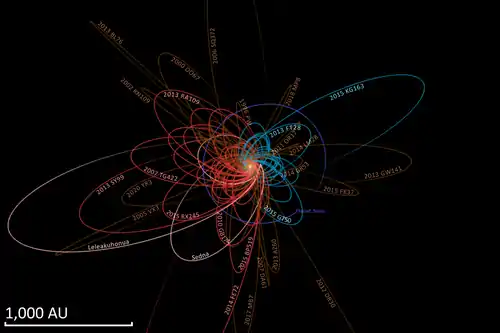2012 VP113
2012 VP113, also known by its nickname "Biden", is a trans-Neptunian object of the sednoid population, located in the outermost reaches of the Solar System. It was first observed on 5 November 2012 by American astronomers Scott Sheppard and Chad Trujillo at the Cerro Tololo Inter-American Observatory in Chile.[1][2] The discovery was announced on 26 March 2014.[8][11] The object probably measures somewhere between 300 and 1000 km in diameter, possibly large enough to be a dwarf planet.
 | |
| Discovery [1][2] | |
|---|---|
| Discovered by | |
| Discovery site | Cerro Tololo Obs. |
| Discovery date | 5 November 2012 (announced: 26 March 2014) |
| Designations | |
| 2012 VP113 | |
| "Biden" (nickname) | |
| Orbital characteristics [3][5] | |
| Epoch 27 April 2019 (JD 2458600.5) | |
| Uncertainty parameter 5 | |
| Observation arc | 5.0 yr (1,840 d) |
| Aphelion | 436.143 AU (65.2461 Tm) |
| Perihelion | 80.389 AU (12.0260 Tm) |
| 258.266 AU (38.6360 Tm) | |
| Eccentricity | 0.68876 |
| |
| 3.558° | |
| 0° 0m 0.72s / day | |
| Inclination | 24.110° |
| 90.680° | |
| 293.62° | |
| Physical characteristics | |
Mean diameter | |
| |
| 23.34[10] | |
Classification and physical characteristics
2012 VP113 is the minor planet with the farthest known perihelion (closest approach to the Sun) in the Solar System, greater than Sedna's.[12] Though its perihelion is farther, 2012 VP113 has an aphelion only about half of Sedna's. It is the second discovered sednoid, with semi-major axis beyond 150 AU and perihelion greater than 50 AU. The similarity of the orbit of 2012 VP113 to other known extreme trans-Neptunian objects led Scott Sheppard and Chad Trujillo to suggest that an undiscovered object, Planet Nine, in the outer Solar System is shepherding these distant objects into similar type orbits.[8]
It has an absolute magnitude of 4.0,[1] which makes it likely to be a dwarf planet,[9] and it is accepted as a dwarf planet by some.[13] It is expected to be about half the size of Sedna and similar in size to Huya.[7] Its surface is thought to have a pink tinge, resulting from chemical changes produced by the effect of radiation on frozen water, methane, and carbon dioxide.[14] This optical color is consistent with formation in the gas-giant region and not the classical Kuiper belt, which is dominated by ultra-red colored objects.[8]
History
Discovery

2012 VP113 was first observed on 5 November 2012[2] with NOAO's 4-meter Víctor M. Blanco Telescope at the Cerro Tololo Inter-American Observatory.[15] Carnegie's 6.5-meter Magellan telescope at Las Campanas Observatory in Chile was used to determine its orbit and surface properties.[15] Before being announced to the public, it was only tracked by Cerro Tololo Inter-American Observatory (807) and Las Campanas Observatory (304).[1] It has an observation arc of about 5 years.[3] Two precovery measurements from 22 October 2011 have been reported.[1] A primary issue with observing it and finding precovery observations of it is that at an apparent magnitude of 23, it is too faint for most telescopes to easily observe.
Nickname
2012 VP113 was abbreviated "VP" and nicknamed "Biden" by the discovery team, after Joe Biden who, at the time of discovery, was vice president ("VP") of the United States.[11]
Orbit
2012 VP113 has the largest perihelion distance of any known object in the Solar System.[16] Its last perihelion was around 1979,[lower-alpha 1] at a distance of 80 AU;[3] it is currently 84 AU from the Sun. As of 2018, only nine other Solar System objects are known to have perihelia larger than 47 AU: Sedna (76 AU), 2014 FZ71 (56 AU), 2014 FC72 (52 AU), 2004 XR190 (51 AU), 2015 FJ345 (51 AU), 2013 SY99 (50 AU), 2010 GB174 (49 AU), 2014 SR349 (48 AU) and (474640) 2004 VN112 (47 AU).[16] The paucity of bodies with perihelia at 50–75 AU appears not to be an observational artifact.[8]
It is possibly a member of a hypothesized Hills cloud.[7][15][17] It has a perihelion, argument of perihelion, and current position in the sky similar to those of Sedna.[7] In fact, all known Solar System bodies with semi-major axes over 150 AU and perihelia greater than Neptune's have arguments of perihelion clustered near 340°±55°.[8] This could indicate a similar formation mechanism for these bodies.[8] (148209) 2000 CR105 was the first such object discovered.
It is currently unknown how 2012 VP113 acquired a perihelion distance beyond the Kuiper belt. The characteristics of its orbit, like those of Sedna's, have been explained as possibly created by a passing star or a trans-Neptunian planet of several Earth masses hundreds of astronomical units from the Sun.[18] The orbital architecture of the trans-Plutonian region may signal the presence of more than one planet.[19][20] 2012 VP113 could even be captured from another planetary system.[13] However, it is considered more likely that the perihelion of 2012 VP113 was raised by multiple interactions within the crowded confines of the open star cluster in which the Sun formed.[7]
 Simulated view showing the orbit of 2012 VP113
Simulated view showing the orbit of 2012 VP113 2012 VP113 orbit in white with hypothetical Planet Nine
2012 VP113 orbit in white with hypothetical Planet Nine The orbits of known distant objects with large aphelion distances over 200 AU
The orbits of known distant objects with large aphelion distances over 200 AU
See also
- List of Solar System objects most distant from the Sun in 2015
- 90377 Sedna (relatively large and also distant body)
- 541132 Leleākūhonua (distant sednoid)
- List of hyperbolic comets
- Other large aphelion objects
Notes
- The 1-sigma uncertainty in the year of perihelion passage is ~4 years using JPL solution 2.[3]
References
- "2012 VP113". Minor Planet Center. Retrieved 14 November 2018.
- "MPEC 2014-F40 : 2012 VP113". IAU Minor Planet Center. 26 March 2014. (K12VB3P)
- "JPL Small-Body Database Browser: (2012 VP113)" (2016-11-04 last obs.). Jet Propulsion Laboratory. Retrieved 14 November 2018.
- Johnston, Wm. Robert (7 October 2018). "List of Known Trans-Neptunian Objects". Johnston's Archive. Retrieved 14 November 2018.
- Malhotra, Renu; Volk, Kathryn; Wang, Xianyu (2016). "Corralling a distant planet with extreme resonant Kuiper belt objects". The Astrophysical Journal Letters. 824 (2): L22. arXiv:1603.02196. Bibcode:2016ApJ...824L..22M. doi:10.3847/2041-8205/824/2/L22.
- Horizons output. "Barycentric Osculating Orbital Elements for 2012 VP113". Retrieved 23 January 2016. (Ephemeris Type:Elements and Center:@0)
- Lakdawalla, Emily (26 March 2014). "A second Sedna! What does it mean?". Planetary Society blogs. The Planetary Society.
- Trujillo, C. A.; Sheppard, S. S. (2014). "A Sedna-like body with a perihelion of 80 astronomical units" (PDF). Nature. 507 (7493): 471–474. Bibcode:2014Natur.507..471T. doi:10.1038/nature13156. PMID 24670765. Archived from the original (PDF) on 16 December 2014. Retrieved 29 August 2015.
- Brown, Michael E. "How many dwarf planets are there in the outer solar system?". California Institute of Technology. Retrieved 14 November 2018.
- "2012 VP113 – Summary". AstDyS-2, Asteroids – Dynamic Site. Retrieved 14 November 2018.
- Witze, Alexandra (26 March 2014). "Dwarf planet stretches Solar System's edge". Nature. doi:10.1038/nature.2014.14921.
- Chang, Kenneth (26 March 2014). "A New Planetoid Reported in Far Reaches of Solar System". The New York Times.
- Sheppard, Scott S. "Beyond the Edge of the Solar System: The Inner Oort Cloud Population". Department of Terrestrial Magnetism, Carnegie Institution for Science. Archived from the original on 30 March 2014. Retrieved 27 March 2014.
- Sample, Ian (26 March 2014). "Dwarf planet discovery hints at a hidden Super Earth in solar system". The Guardian.
- "NASA Supported Research Helps Redefine Solar System's Edge". NASA. 26 March 2014. Retrieved 26 March 2014.
- "JPL Small-Body Database Search Engine: q > 47 (AU)". JPL Solar System Dynamics. Retrieved 12 March 2018.
- Wall, Mike (26 March 2014). "New Dwarf Planet Found at Solar System's Edge, Hints at Possible Faraway 'Planet X'". Space.com web site. TechMediaNetwork. Retrieved 27 March 2014.
- "A new object at the edge of our Solar System discovered". Physorg.com. 26 March 2014.
- de la Fuente Marcos, Carlos; de la Fuente Marcos, Raúl (1 September 2014). "Extreme trans-Neptunian objects and the Kozai mechanism: signalling the presence of trans-Plutonian planets". Monthly Notices of the Royal Astronomical Society: Letters. 443 (1): L59–L63. arXiv:1406.0715. Bibcode:2014MNRAS.443L..59D. doi:10.1093/mnrasl/slu084.
- de la Fuente Marcos, Carlos; de la Fuente Marcos, Raúl; Aarseth, S. J. (11 January 2015). "Flipping minor bodies: what comet 96P/Machholz 1 can tell us about the orbital evolution of extreme trans-Neptunian objects and the production of near-Earth objects on retrograde orbits". Monthly Notices of the Royal Astronomical Society. 446 (2): 1867–1873. arXiv:1410.6307. Bibcode:2015MNRAS.446.1867D. doi:10.1093/mnras/stu2230.
External links
| Wikimedia Commons has media related to 2012 VP113. |
- 2012 VP113 Inner Oort Cloud Object Discovery Images from Scott S. Sheppard/Carnegie Institution for Science.
- 2012 VP113 has Q=460 ± 30 (mpml: CFHT 2011-Oct-22 precovery)
- List of Known Trans-Neptunian Objects, Johnston's Archive
- List Of Centaurs and Scattered-Disk Objects, Minor Planet Center
- 2012 VP113 at the JPL Small-Body Database




_(cropped).jpg.webp)
